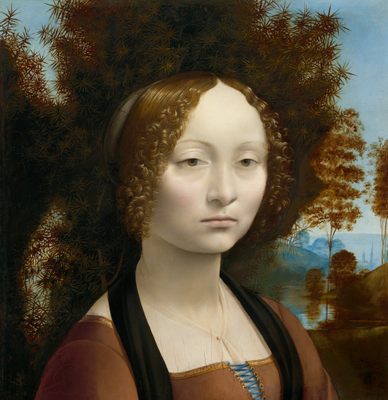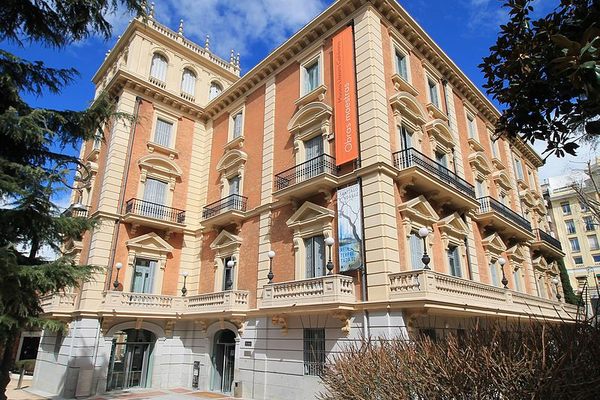About
Unlike Mona Lisa, Ginevra de' Benci doesn’t offer even a hint of a smile; it’s just one of the things that makes Leonardo Da Vinci’s portrait of the wealthy Italian teenager even more intriguing than the famed denizen of the Louvre. The young artist painted de' Benci in the 1470s—20 years before he created the Mona Lisa—possibly on the occasion of her engagement at age 16. It was one of Da Vinci’s first experiments with oils and contemporary critics were entranced by the results. “It seemed to be not a portrait by Ginevra herself,” one wrote.
“Ginevra herself” now resides in the National Gallery of Art in Washington D.C. It’s the only Da Vinci painting in the Western Hemisphere—or, at least, an unsigned portion of the original. At some point, the portrait was sliced nearly in half, lopping off de’ Benci’s torso and hands, perhaps because of damage. Da Vinci’s preliminary sketches show what the lost portion of the painting may have looked like; de’ Benci’s arms crossed at her waist, a small flower in one hand. Painted on the back of the small portrait—only about 15 inches square—is “Virtutem forma decorat,” Latin for “beauty adorns virtue.”
One of only 20 known Da Vinci paintings, de’ Benci’s portrait spent about half its existence in the possession of the Liechtenstein royal family, much of that in a castle in Vaduz. During World War II, it was successfully hidden away in a wine cellar. It may never have made its way to the United States if not for the unflagging interest of John Walker, the National Gallery of Art’s second curator. In 1963, the National Gallery displayed Leonardo da Vinci’s Mona Lisa, on loan from France. The United States debut of the painting was a stunning success, and it inspired Walker to acquire a Da Vinci for permanent display at the National Gallery. There was only one in a private collection: Ginevra de' Benci.
Walker made many trips to Vaduz over the next several years, until Prince Franz Joseph II, whose family lost much of their fortune in World War II, finally agreed to sell the piece to pay for his son’s wedding. The National Gallery outbid other interested parties, offering a rumored $5 million for the portrait, then the highest sum ever paid for a painting.
In January 1967, about 500 years after it was painted in Italy, De’ Benci’s portrait arrived in the United States via a Zurich to New York flight. It was carried in a gray American Tourister suitcase specially designed inside to protect the art and traveled under the name “Mrs. Modestini” next to art expert Mario Modestini. De’ Benci got the window seat.
Related Tags
Know Before You Go
Until early 2024, the portrait is on display in Gallery 39 of the National Gallery of Art’s West Building. Its usual home in Gallery 6 is under renovation.
Published
December 20, 2023
Sources
- https://www.theartnewspaper.com/2023/07/03/leonardo-da-vinci-national-gallery-washington-relocation-renovations
- https://www.nga.gov/press/archive/ginevra.html#:~:text=The%20Gallery%20is%20the%20home,transport%20the%20painting%20in%201967.
- https://www.washingtonpost.com/news/going-out-guide/wp/2018/08/08/leonardo-da-vincis-only-painting-in-the-americas-can-be-found-in-d-c-and-it-arrived-here-in-a-suitcase/
- https://boundarystones.weta.org/2020/01/27/new-girl-town-washington-gets-leonardo
- https://www.nga.gov/collection/art-object-page.50724.html
- https://www.nga.gov/collection/highlights/da-vinci-ginevra-de-benci.html
- https://artsandculture.google.com/story/before-the-mona-lisa-leonardo%E2%80%99s-captivating-ginevra-de%E2%80%99-benci-national-gallery-of-art-washington-dc/OQURYiUMdaP6LQ?hl=en





































